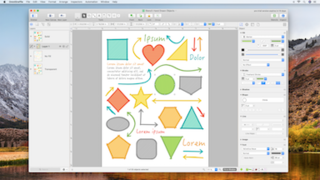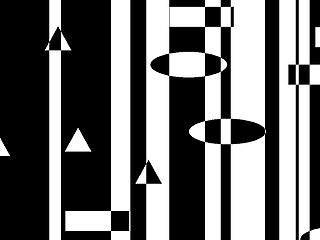This page is based on this
Wikipedia article Text is available under the
CC BY-SA 4.0 license; additional terms may apply.
Images, videos and audio are available under their respective licenses.

Graffiti is writing or drawings made on a wall or other surface, usually without permission and within public view. Graffiti ranges from simple written words to elaborate wall paintings, and it has existed since ancient times, with examples dating back to ancient Egypt, ancient Greece, and the Roman Empire.

The stencil duplicator or mimeograph machine is a low-cost duplicating machine that works by forcing ink through a stencil onto paper. The mimeograph process should not be confused with the spirit duplicator process.

Screen printing is a printing technique whereby a mesh is used to transfer ink onto a substrate, except in areas made impermeable to the ink by a blocking stencil. A blade or squeegee is moved across the screen to fill the open mesh apertures with ink, and a reverse stroke then causes the screen to touch the substrate momentarily along a line of contact. This causes the ink to wet the substrate and be pulled out of the mesh apertures as the screen springs back after the blade has passed. One color is printed at a time, so several screens can be used to produce a multicoloured image or design.
A cabochon is a gemstone which has been shaped and polished as opposed to faceted. The resulting form is usually a convex (rounded) obverse with a flat reverse. Cutting en cabochon is usually applied to opaque gems, while faceting is usually applied to transparent stones. Hardness is also taken into account as softer gemstones with a hardness lower than 7 on the Mohs hardness scale are easily scratched, mainly by silicon dioxide in dust and grit. This would quickly make translucent gems unattractive—instead they are polished as cabochons, making the scratches less evident.

Shadow volume is a technique used in 3D computer graphics to add shadows to a rendered scene. They were first proposed by Frank Crow in 1977 as the geometry describing the 3D shape of the region occluded from a light source. A shadow volume divides the virtual world in two: areas that are in shadow and areas that are not.

OmniGraffle is a diagramming and digital illustration application for macOS and iOS created by The Omni Group.
A geometry template is a piece of clear plastic with cut-out shapes for use in mathematics and other subjects in primary school through secondary school. It also has various measurements on its sides to be used like a ruler. In Australia, popular brands include Mathomat and MathAid.

The Gestetner is a type of duplicating machine named after its inventor, David Gestetner. During the 20th century, the term Gestetner has been used as a verb—as in Gestetnering. The Gestetner company established its base in London, filing its first patent in 1879. The business grew, remaining within the control of the Gestetner family, and acquiring other businesses. In 1996, the Gestetner company was acquired by the Ricoh Corporation of Japan.

Aerosol paint is a type of paint that comes in a sealed pressurized container and is released in an aerosol spray when depressing a valve button. A form of spray painting, aerosol paint leaves a smooth, evenly coated surface, unlike many traditional rolled or brushed paints. Standard sized cans are lightweight, portable, cheap, and easy to store. Aerosol primer can be applied directly to bare metal and many plastics.
Monoprinting is a form of printmaking that has lines or images that can only be made once, unlike most printmaking, which allows for multiple originals. There are many techniques of mono-printing. Examples of standard printmaking techniques which can be used to make monoprints include lithography, woodcut, and etching.
Meek is a notable street artist operating out of Melbourne, Australia, and specialising in the subgenre of stencil graffiti.

The Caves of Gargas in the Pyrenees region of France are known for their cave art from the Upper Paleolithic period - about 27,000 years old.

ConceptDraw DIAGRAM is proprietary diagramming software used to create business graphics, including: diagrams, flowcharts, Infographics, data visualization for business process models, data presentation and project management documentation. It can also be used for creating professional and technical diagrams, such as: UML diagrams, DFD, ERD, computer networks topology, engineering schemes and other technical graphic formats.
The program was developed by CS Odessa in 1999. It is compatible with Microsoft Windows and macOS platforms. Since 2008, it has formed a part of ConceptDraw Office. A set of solution add-ons that include collections of task-oriented templates and vector stencils libraries, have been released for ConceptDraw DIAGRAM, relating to certain industry-specific graphical tasks. The software also contains a set of tools for vector graphics drawing, along with a built-in presentation mode.
Stencil printing is the process of depositing solder paste on the printed wiring boards (PWBs) to establish electrical connections. It is immediately followed by the component placement stage. The equipment and materials used in this stage are stencil, solder paste, and a printer.

The Caves in the district of Maros are located in Bantimurung district (kecamatan), South Sulawesi, Indonesia. They contain paintings from the paleolithic.













